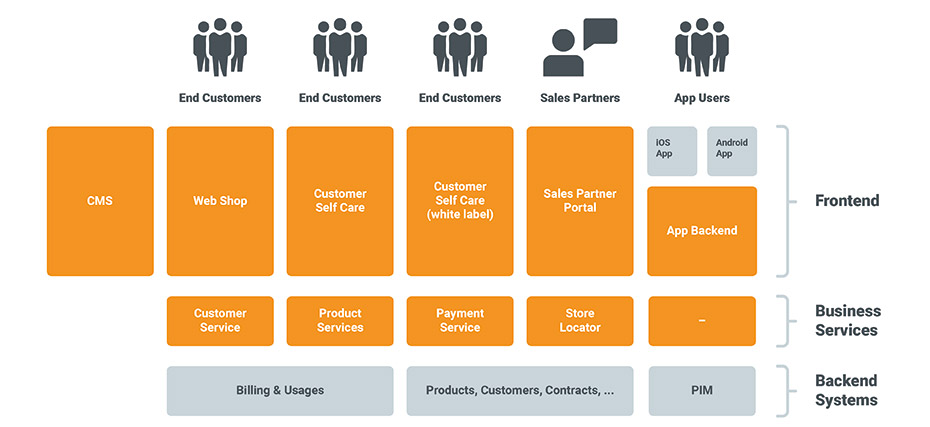Get in touch
Next to employees, the most important factor for sustainable success within an agile structure is the customer, whom we at AOE consider to be an active member of our own teams. In order to work optimally with our customers, we must know and understand the economic conditions and market aspects of each company and industry. This then helps us to jointly define the project KPIs and success parameters – and thus to ensure the RoI. In the end we want to achieve a benefit for our customers’ customers. In this final installment of our three-part blog series on agility in Enterprises, we will take a closer look at the importance of the customers for the entire process and explain why it really isn’t that hard too implement agile practices.
These considerations as well as the business model and business processes influence the concept, design and architecture of a solution. To grow with the customer, the solution must also be scalable. This means “small” in a defined market/customer segment, which must then scale by a factor of ten or more.
Therefore, at the beginning of each project we put together a dedicated team for the client; this team is responsible for all aspects of project implementation. This starts with the first joint briefings and workshops, includes the business enabling phase (consulting) as well as concept/design of the solution and development, up to the implementation of the solution, testing and quality assurance. In most cases, the service includes long-term support of the customer as well as the continuous development of the solution. Depending on the customer's requirements and location, the composition of the team(s) and the specifics of the project, teams can be spread over several locations, often across different time zones and continents. Here, too, an agile approach helps to optimize processes, procedures and cooperation.
Involving customers in projects right from the start has many advantages:

A concrete example is the mobile phone provider congstar, which in 2008, together with AOE, set out on the road to agility. congstar decided very early on to map its business model exclusively via the Internet. A step that not only affected the entire IT infrastructure, but also entailed a transformation of the entire company – including structures and work processes.
At the same time, structures were created together with the customer to drive forward the development of the online sales and self-care portal on the basis of agile development methods and work processes. congstar is supported by AOE Scrum teams. Product Owners and Scrum Masters are on the client side in Cologne; AOE developers work in Wiesbaden and Frankfurt. New software is developed in two-week sprints and is accepted by the customer at the end of each sprint. During the sprints, there is regular exchange of information about the progress of the new features discussed at the beginning of each sprint.
Over the years, the online solution has been jointly expanded and further developed to adapt it to continuously changing circumstances.
From the very beginning, the IT architecture has been aligned with the business model as well as value for the customer, which is the key to congstar's success (Fig. 1).

It was designed in a modular way so that changes in the solution can be made easily and without having to intervene in the running system. At the same time, the solution is scalable so that it can be adapted to the current conditions.
Gradually, more and more features have been added to the congstar platform (currently, more than 100 different IT systems are working in the background) in order to offer customers the greatest possible flexibility in the configuration of their smartphone contracts.
With a prepaid account, for example, it is possible to adjust the existing contract as required and add minutes, SMS- and storage options as well as the transition to the LTE network. For example, data volume can be added several times a month and used up within different time periods.
From the company's point of view, the solution is configured in such a way that, for example, the prices or offers change depending on the entry link through which the user accessed the respective page. The system can also be optimally tailored to individual user behavior.
If companies observe a few principles, the introduction of agile working methods doesn't have to be that difficult. Special attention should be paid to the following “Dos and Don'ts”:
In order to be able to work in an agile manner, a company must change its mindset. It is not enough to simply introduce Scrum, proclaim agility as the new axiom and then expect that success will come naturally. This holds especially true when a crisis such as Corona dramatically affects society on a global scale as well as the worldwide economy. Even though agile concepts have been around for decades, they particularly apply to current events.
For all the advantages that agile working methods offer, companies should first consider the core that makes them unique when transforming. They should answer the following question: "What is my “unfair” competitive advantage and “the” benefit for my customers? This defines: “What do I hold on to, what aspects of agile working practices do I take on board?” The right mix is decisive. Ultimately, all employees must support agility. As mentioned above, this is achieved most quickly when enthusiastic early adopters are brought on board. When building new business models, the customer must be placed even more in the focus of efforts. Project success is only possible in cooperation with the customer. Ideally, the corporate cultures of customer and service provider complement each other – and grow together over time. In any case, in an agile environment, the customer must be involved in the project from the very beginning. Motto: “Talk to each other – not about each other.”
Further insights into the topic and how agility can be implemented in companies can be found in the first two parts of this blog series:
This blog post is an excerpt of the article “So geht agil: Ein Bauplan für jedes Unternehmen”, which originally appeared in German on ibusiness.